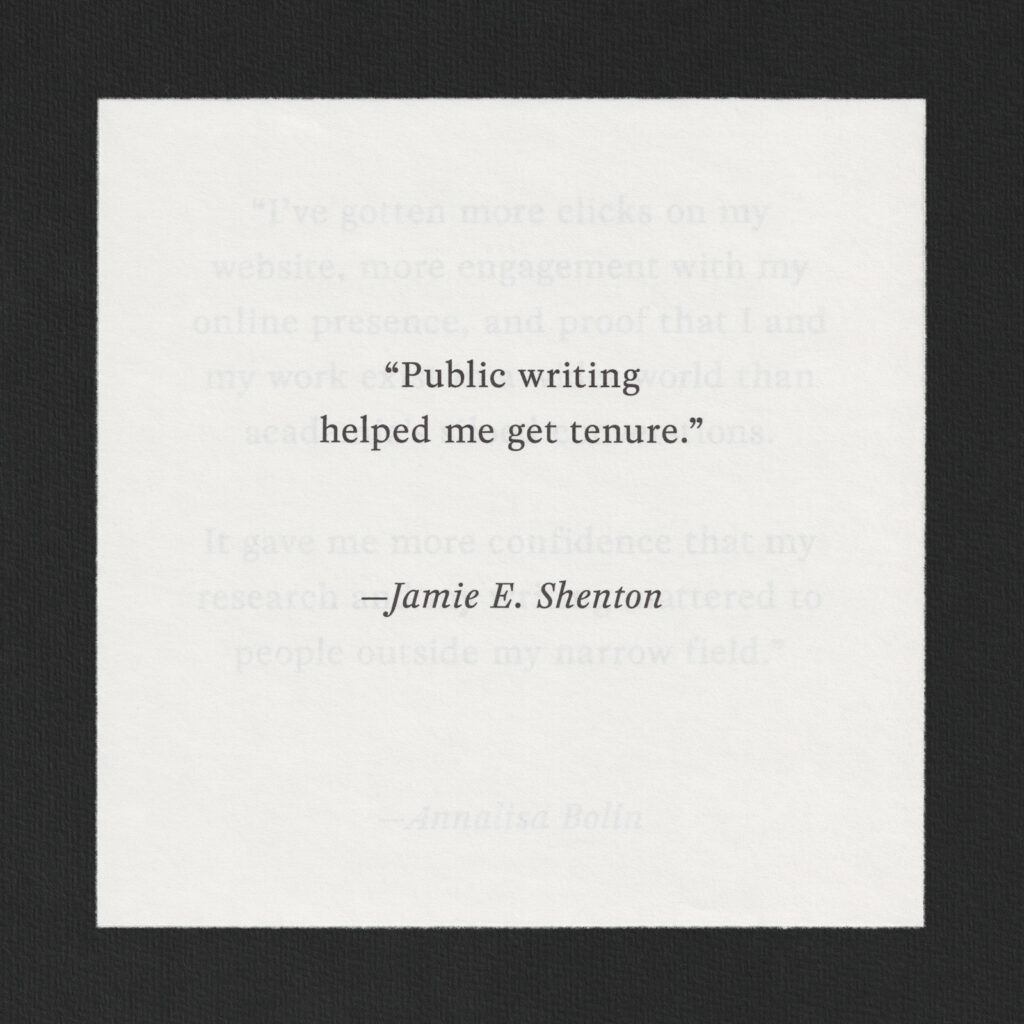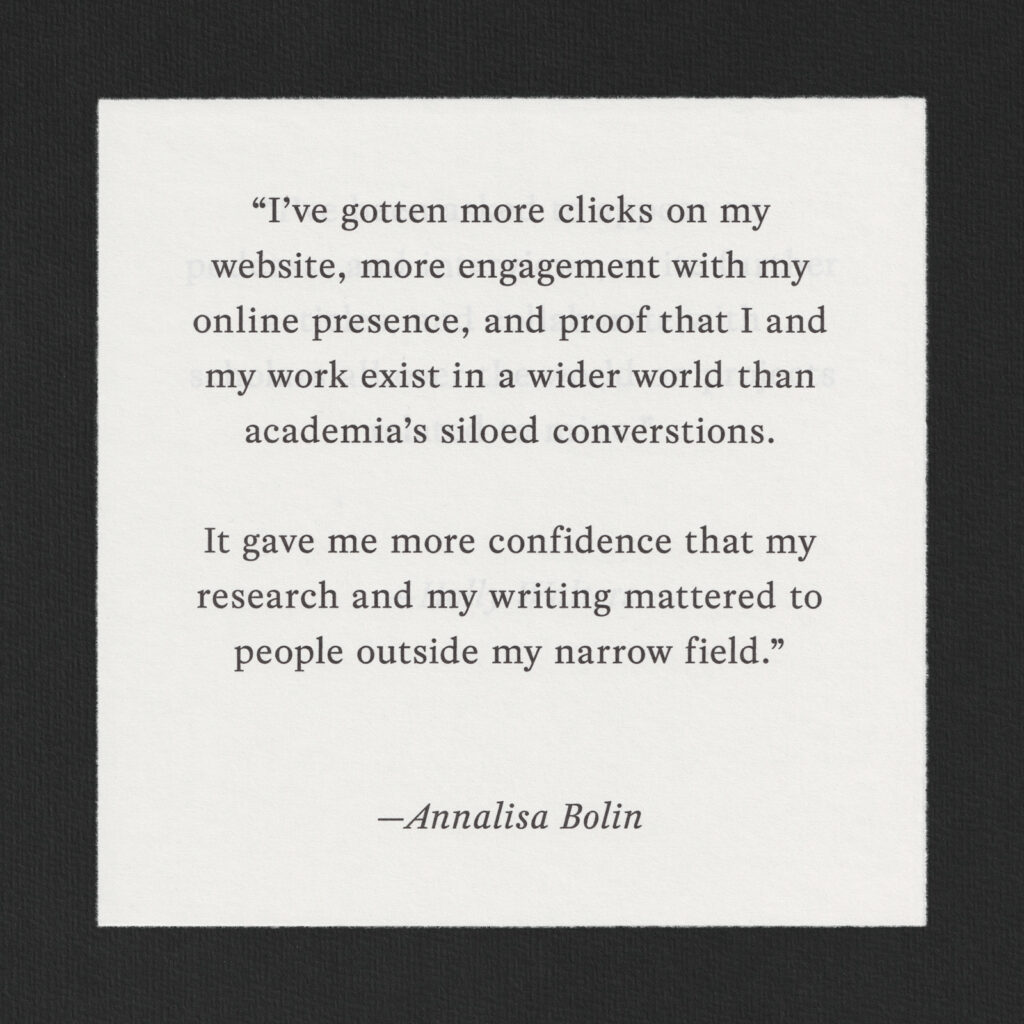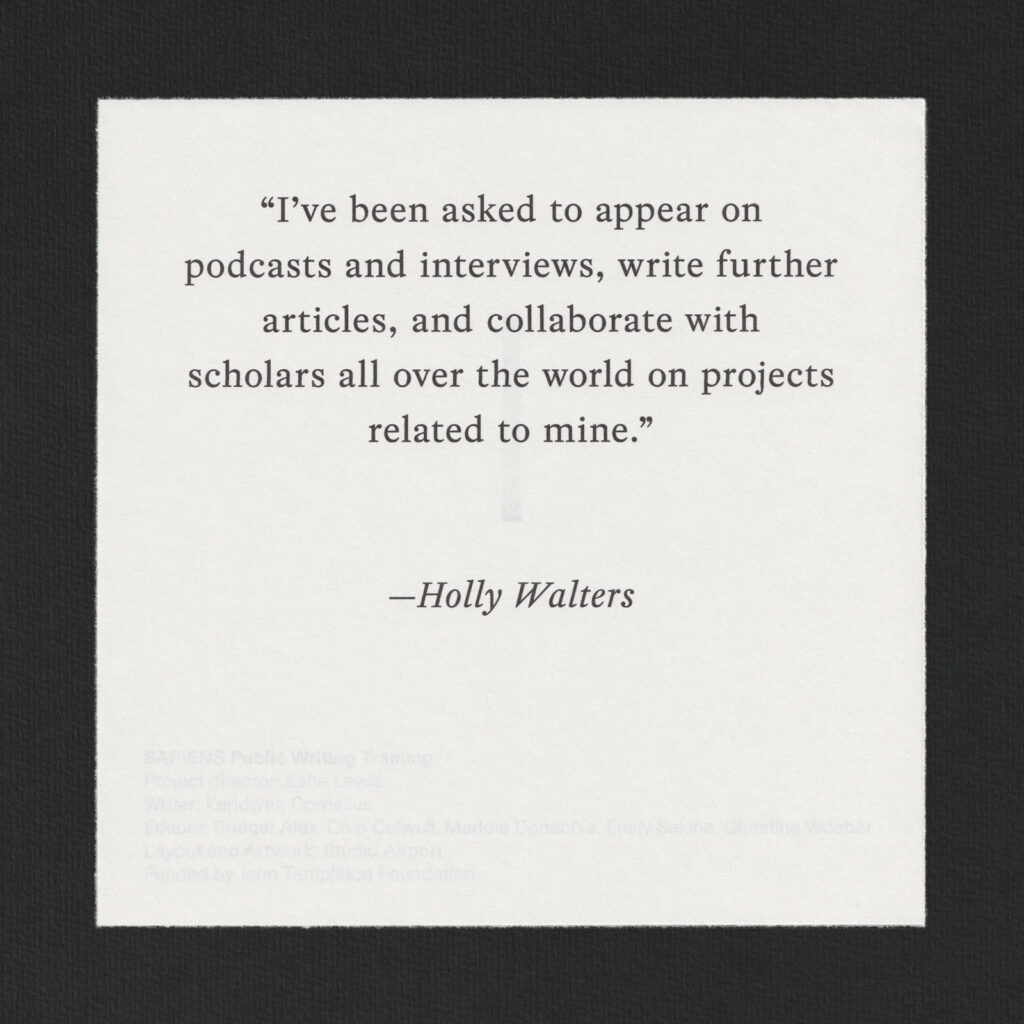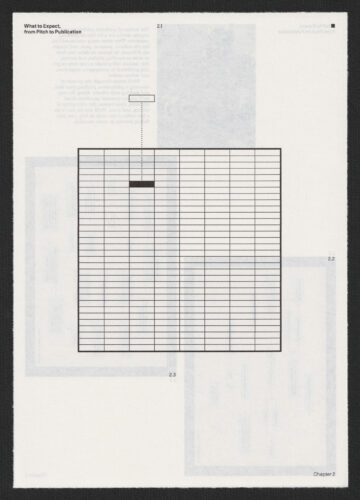Chapter 1
Why Write for the Public?

Sharing outward from one’s inner world is a central motivation for many scholars who write for general publics.
INTRODUCTION
Public-facing engagement can make a huge difference to both individuals and society at large. Just ask Jane Goodall.
In 1960, Goodall made an observation that would overturn the scientific consensus about what makes humans unique. At the time, it was widely believed only humans used tools. Yet she saw a chimpanzee strip the leaves off a twig and use it to “fish” for termites. Goodall reported her findings in Nature, and the academic article made ripples among scientists.
Then she wrote an essay and starred in a documentary for National Geographic. The article and film brought to life the moving story of a 26-year-old without a bachelor’s degree boldly defying conventional research methods and forming relationships with chimps she named David Greybeard and Mrs. Maggs. These personal portrayals struck a chord with people around the world and had a seismic impact on Goodall’s career and public perceptions of primates.
Though Goodall initially shied away from publicity, she eventually championed the benefits of sharing research with broad audiences through the media. “Why should we keep [scientific observations] in an ivory tower,” she asked in a 2015 lecture, “when they can make so much difference?”
Goodall’s story is, of course, exceptional. Writing articles and giving interviews in popular media rarely catapults researchers into superstardom. But as you’ll see from the testimonials below, the rewards of public writing can still be significant, satisfying, and transformative.
SIMULTANEOUSLY IMPROVE YOUR ACADEMIC AND PUBLIC WRITING
On a personal level, learning effective public writing skills can benefit your career at any stage, whether you’re earning a master’s degree, advancing along the tenure track, working in heritage management, or transitioning out of academia into a nongovernmental organization or other applied position. On an interpersonal level, making research insights accessible to the general public can elevate collective conversations, positively impact communities, and open hearts and minds to new perspectives.
Many anthropologists feel pressure to “publish or perish.” So you may worry that public writing could take time and energy away from publishing in academic journals. However, researchers consistently report that writing for the public supports and nourishes their academic work.
By learning how to engage readers with fascinating storytelling and clear insights, you’ll simultaneously strengthen your public and academic writing skills. You’ll hone techniques that can help you write attention-grabbing grant applications, book proposals, and cover letters. You’ll sharpen your ability to verbally communicate, whether you’re being interviewed for a job, networking at a conference, teaching a class, or doing community engagement.

In addition, public writing can help generate research ideas and directly boost your career. “Public writing helped me get tenure,” says Jamie E. Shenton, a cultural anthropologist who has written several stories for SAPIENS. “Not only did my institution consider my public-facing essays as part of my tenure file, but public writing also helped me refine ideas that were later published as part of longer journal articles.”
Though it takes time to learn the skills, writing for popular media can help you efficiently increase your output of published articles. “Unlike the long and winding road of trying to do a journal article, your work gets published fast,” says cultural anthropologist Orin Starn. Plus, he adds, “people outside our little anthropology subfields actually read it!”
REACH AND IMPACT DIVERSE COMMUNITIES
That’s perhaps the biggest advantage of writing for popular publications: a wide readership.
Academic articles are frequently blocked behind paywalls, buried by search engine algorithms, and filled with jargon that makes them incomprehensible and unappealing to general readers. The majority of these articles are read by a small number of people, many of whom work in the same field. According to an analysis of the popular outlets TIME and NBC News, between 1990 and 2001, less than 0.013–0.34 percent of scientific papers got attention in mass media. Those numbers become even more infinitesimal if you take out papers on health and medicine.
The good news is anthropology tends to garner more public interest—at least for archaeology and paleoanthropology research. One of our SAPIENS editors, Bridget Alex, and her collaborators, Rowan Flad and Jenny Ji, quantified the press coverage of archaeology papers published from 2015 to 2020 in seven leading scientific journals (Nature, Science, Science Advances, Nature Communications, Scientific Reports, PNAS, and Antiquity). Of the 1,155 articles reviewed, 38 percent were written up in one or more major U.S. news outlets, such as The New York Times, Forbes, and National Geographic. Meanwhile, 53 percent of research papers focused on paleoanthropology research received U.S. media coverage.
Another issue is that systems of gatekeeping within academia favor prestige networks that are not necessarily based on merit. This may prevent less well-connected individuals from publishing worthy research in top journals. Writing for popular publications can be a way to sidestep and combat these hierarchical systems.
By writing for popular media, your voice can be heard by thousands or even millions of people who represent diverse backgrounds and interests. Knowing your work is touching, informing, inspiring, and riling up readers around the world can be personally and collectively fulfilling. It can impact your career and the communities you care about in a variety of positive ways.

Anthropologist Annalisa Bolin told us that after co-writing a SAPIENS essay on decolonizing cultural heritage, “I’ve gotten more clicks on my website, more engagement with my online presence, and proof that I and my work exist in a wider world than academia’s siloed conversations. It gave me more confidence that my research and my writing mattered to people outside my narrow field.” Bolin also says her essay serves as a calling card she can send to people of any background, so they can quickly and easily understand her work.
Public writing can serve as a virtual networking forum that attracts professional partnerships and opportunities. A variety of people—including researchers, journalists, and activists—peruse public-facing sources in search of people they can collaborate with, interview, and promote.
For example, a reporter heard a SAPIENS podcast written and produced by Adam Netzer Zimmer, a Ph.D. candidate in archaeology, and was inspired to write a story about the research in National Geographic. Cultural anthropologist Holly Walters says that thanks to writing for The Conversation and SAPIENS, “I’ve been asked to appear on podcasts and interviews, write further articles, and collaborate with scholars all over the world on projects related to mine.”

Anthropology master’s student Kootyin Chow says that after writing about her life in an ecovillage in Hong Kong, she received several inquiries from like-minded people who are interested in getting involved with this movement. “It allowed me and my community to get in touch with those we would otherwise never have reached or contacted through social media alone,” she says.
The impact of a single article can sometimes snowball. At some outlets—including SAPIENS, The Conversation, and Knowable magazine—writers can publish under the Creative Commons license. This allows their articles to be republished in outlets such as The Atlantic, Smithsonian magazine, and Scientific American, expanding the author’s audience further.
TRANSFORM CONVERSATIONS AND PERSPECTIVES
Connecting with broad audiences can amplify your impact on the communities and issues you care about. Your public writing can add nuance and empathy to broader conversations, increasing openness and connectedness between groups.
In the Aeon essay “Neither Nasty nor Brutish,” anthropologist Cathryn Townsend recounts her experience of living in Central Africa with the Ik people, who have historically been vilified as heartless and selfish. Both in the article and in interviews with other popular outlets, Townsend dismantles this misunderstanding of the Ik, showing how these people are deeply resilient and as generous as any other human community.
Public writing can also shape discourse within specific areas of expertise and in larger conversations among people who inform policy. Anthropologist Hugh Gusterson, who earned an American Anthropological Association Media Award for his articles, says he wrote a somewhat critical piece about nuclear weapons that was widely circulated in the nuclear policy arena. The late anthropologist David Graeber’s writings and activism greatly contributed to the Occupy movement, shaped the political ideologies of his countless fans, and opened people’s eyes to myriad alternative ways societies could be constructed.
Shining a spotlight on anthropological perspectives helps the field be more inclusive and better appreciated. Amid funding cuts to many anthropology and humanities programs, communicating the value of this research to the general public is increasingly essential. For example, the National Science Foundation, which is accountable to U.S. taxpayers, asks grant applicants to submit a statement describing each project’s “broader impacts.” For those receiving public grants from the NSF or other organizations, public writing is a great tool to amplify a project’s benefits to society.

Public writing is your chance to bring people new perspectives on our world.
Jonas Jacobsson/Unsplash
While some anthropological topics remain perennially popular in the press (think Vikings, Neanderthals, and mummies), a vast majority of subjects and subdisciplines receive little ink. This narrow lens can perpetuate dominant cultural narratives, stereotypes, and unconscious biases. For example, the aforementioned study from Alex, Flad, and Ji found that U.S. mass media publish more articles about archaeological research investigating Judeo-Christian and White European peoples than those of other cultural backgrounds.
By writing for popular outlets, you can bring to life complex, nuanced stories about people and places that don’t often receive media attention. For example, Somali archaeologist Sada Mire wrote an op-ed in The Guardian about efforts to showcase overlooked heritage in Somalia and to connect people across Africa with their own history. Anthropologist Antonio Montañés Jiménez and Rroma human rights activist Demetrio Gómez Ávila co-wrote a SAPIENS essay revealing the rise in prejudice toward Rroma people during the height of the COVID-19 crisis.
Brendane A. Tynes, a Ph.D. candidate in anthropology studying anti-Black racism, shone a light on how policing intersects with patriarchy and intimate partner violence. Tynes also co-hosted the Zora’s Daughters Podcast, which uses Black feminist anthropology to “empower listeners to develop the tools and language that starts conversations and sparks change.” She is now the host of black. loved. free., a podcast that brings together Black feminist theory and Black spirituality to study Black liberation movements.
Writing for popular media can also give you a chance to express your unique voice and be more creative than you can in most academic publications. You might play with lyrical language, experiment with comics and illustrations in your articles, or breathe life into an issue with a photo essay. You could write passionately about personal experiences to call for social justice, light-heartedly describe your quirky research, or even use a shit-ton of swear words (in the name of science, of course).
Are you feeling ready to get started?
Below are some activities that can help you address any lingering doubts, gain inspiration, and maintain your motivation to write for the public. Feel free to do any, all, or none of the activities. These chapters aim to benefit you, so focus on whatever actions you find most effective and inspiring.
Activities
Kick-start Your Public Writing Journey
-
Motivation-boosting activity
If you don’t have much experience with public writing, chances are you have some qualms. This could cause you to procrastinate, which is typically a way to cope with anxiety about completing a task. To help you get started, make a list of your concerns and the barriers you face to writing for the public.
Once you bring those worries to your awareness, it’s easier to practice self-compassion, which experts say increases motivation and helps prevent procrastination. Next write down why you want to write for the public and tape the piece of paper somewhere in your workspace that’s highly visible. Reminding yourself of your goals infuses your work with meaning and can help keep you motivated.
-
Inspirational activity
Find an article in a newspaper, magazine, or other popular outlet that resonates with you and ask yourself why you like it. Does it sound like your voice or how you would like your voice to sound? Do you find the story and the people featured in the article inspiring? Does the writing style or the visual elements appeal to your sense of creativity?
Begin collecting articles like this, either in digital or physical form. These are the stories you can turn to when you need a reminder of why you want to write for the public, if you get writer’s block, or when you need inspiration for making your writing more colorful.
-
Accountability activity
Find an accountability partner who has similar goals and think of ways to support each other. If you can’t find someone, announce your goal of writing for the public to your friends in person and/or on social media and ask them to hold you accountable. Be as specific as you can about your goals.








